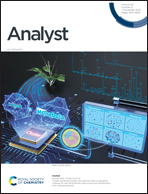Electrochemiluminescence biosensor for cardiac troponin I with signal amplification based on a MoS2@Cu2O–Ag-modified electrode and Ce:ZnO-NGQDs†
Abstract
Cardiac troponin I (cTnI) is one of the structural subunits of cardiac troponin complexes and a significant biomarker of acute myocardial infarction (AMI). Therefore, a sensitive detection of cTnI in the early stages is of great significance. Here, a sensitive sandwiched electrochemiluminescence (ECL) immunosensor was built for the detection of cTnI, where molybdenum disulfide@cuprous oxide–silver nanoparticles (MoS2@Cu2O–Ag) immobilized cTnI the capture antibody (Ab1), and cerium-doped zinc oxide@nitrogen-doped graphene quantum dots (Ce:ZnO@NGQDs) loaded the signal antibody (Ab2). The MoS2@Cu2O–Ag nanoparticles not only indicated excellent electroconductivity and biocompatibility but also provided a large specific surface. Ce:ZnO as a co-reaction accelerator can convert the Ce4+ ↔ Ce3+ reaction and might increase the rate of electron exchange to accomplish signal enhancement. Under optimum conditions, the sensor possessed a wide linear range from 10 pg mL−1 to 100 ng mL−1, and the LOD was 2.90 fg mL−1 (S/N = 3). In addition, the sensor plays a good role in serum detection, indicating that it has potential for application in the detection of biomolecules.

- This article is part of the themed collection: Analyst HOT Articles 2022


 Please wait while we load your content...
Please wait while we load your content...